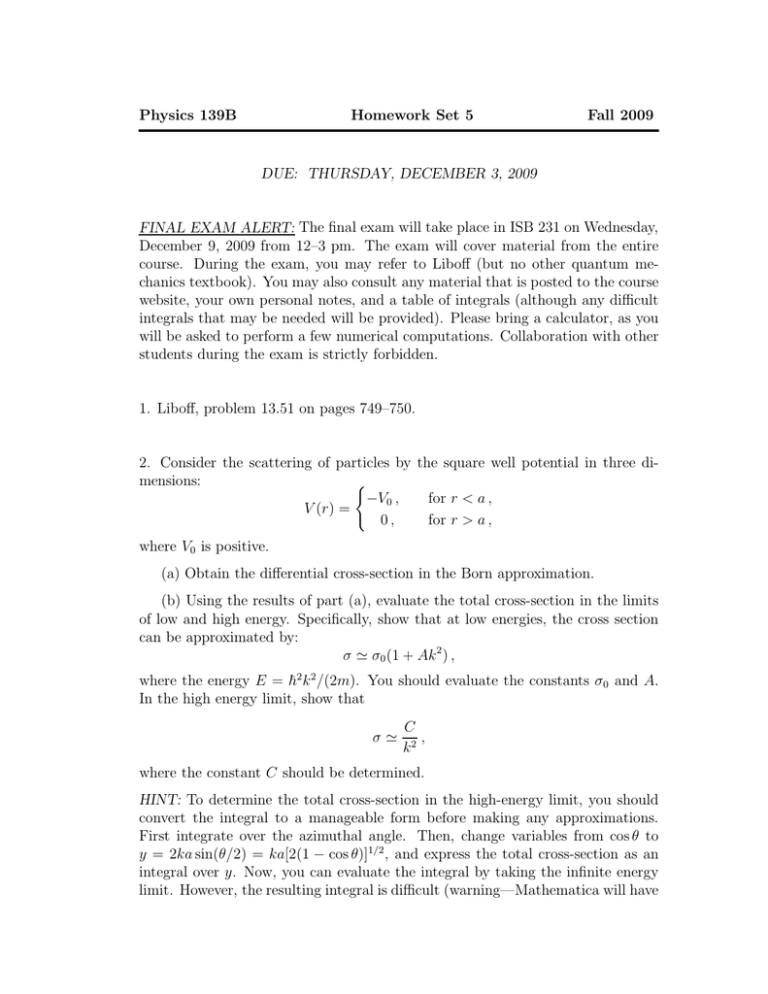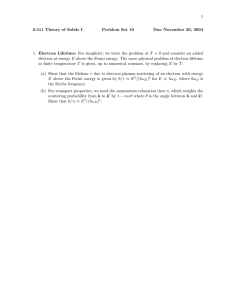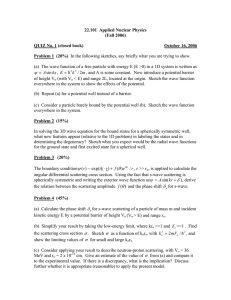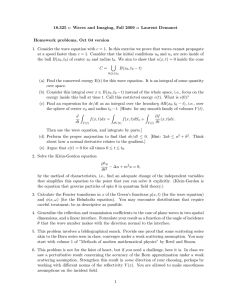Physics 139B Homework Set 5 Fall 2009 DUE: THURSDAY
advertisement

Physics 139B Homework Set 5 Fall 2009 DUE: THURSDAY, DECEMBER 3, 2009 FINAL EXAM ALERT: The final exam will take place in ISB 231 on Wednesday, December 9, 2009 from 12–3 pm. The exam will cover material from the entire course. During the exam, you may refer to Liboff (but no other quantum mechanics textbook). You may also consult any material that is posted to the course website, your own personal notes, and a table of integrals (although any difficult integrals that may be needed will be provided). Please bring a calculator, as you will be asked to perform a few numerical computations. Collaboration with other students during the exam is strictly forbidden. 1. Liboff, problem 13.51 on pages 749–750. 2. Consider the scattering of particles by the square well potential in three dimensions: ( −V0 , for r < a , V (r) = 0, for r > a , where V0 is positive. (a) Obtain the differential cross-section in the Born approximation. (b) Using the results of part (a), evaluate the total cross-section in the limits of low and high energy. Specifically, show that at low energies, the cross section can be approximated by: σ ≃ σ0 (1 + Ak 2 ) , where the energy E = ~2 k 2 /(2m). You should evaluate the constants σ0 and A. In the high energy limit, show that σ≃ C , k2 where the constant C should be determined. HINT: To determine the total cross-section in the high-energy limit, you should convert the integral to a manageable form before making any approximations. First integrate over the azimuthal angle. Then, change variables from cos θ to y = 2ka sin(θ/2) = ka[2(1 − cos θ)]1/2 , and express the total cross-section as an integral over y. Now, you can evaluate the integral by taking the infinite energy limit. However, the resulting integral is difficult (warning—Mathematica will have a very hard time with this, although Maple can do it quite easily!). So, I will help you out by providing the following result: 2n + 1 − p p+1 p−2 2 Z ∞ 2 Γ Γ [jn (y)]2 2 2 dy = , (−1 < Re p < 2n + 1) . p 2n + p + 3 y 0 Γ(p + 1) Γ 2 where jn (y) is a spherical Bessel function and Γ2 (z) is the square of the gamma function. Show that the integral you are trying to evaluate corresponds to a specific choice of n and p above. Then evaluate it. (c) What is the range of validity of your answers to parts (a) and (b). Consider separately the limits of low and high energy. (d) In section 14.2 on pp. 770–771 of Liboff, the s-wave phase shift is obtained. At low energies E = ~2 k 2 /(2m), one may neglect the higher partial waves. Hence, for ka ≪ 1, one can assume that only the s-wave scattering is important. In this limit, compute the differential and total cross-section for the scattering of particles by the square well potential as a function of k1 , where E + V0 = ~2 k12 /(2m). Compare these results to the results of parts (a) and (b). In what limit do the results for the cross-sections coincide? 3. Liboff, problem 14.8 on pages 782. 4. Consider the case of low-energy scattering from a spherical delta-function shell, V (r) = V0 δ(r − a) , where V0 and a are constants. Calculate the scattering amplitude, f (θ), the differential cross-section and the total cross-section, under the assumption that ka ≪ 1, so that only s-wave scattering is important. HINT: Solve the time-independent Schrodinger equation exactly in the case of ℓ = 0 for the radial wave function, R(r) ≡ u(r)/r. Consider separately the cases of r < a and r > a. By integrating the Schrodinger equation from r = a − ǫ to a + ǫ (where 0 < ǫ ≪ 1), show that " # du du 2mV0 = − u(a) . dr a+ǫ dr a−ǫ ~2 Inserting your explicit solutions for u(r) for the two cases r < a and r > a into the equation above, you should be able to determine the s-wave phase shift. 5. This problem provides a crude model for the photoelectric effect. Consider the hydrogen atom in its ground state (you may neglect the spins of the electron and proton). At time t = 0, the atom is placed in a high frequency uniform electric field that points in the z-direction, ~ = E0 ẑ sin ωt . E(t) We wish to compute the transition probability per unit time that an electron is ejected into a solid angle lying between Ω and Ω + dΩ. (a) Determine the minimum frequency, ω0 , of the field necessary to ionize the atom. (b) Using Fermi’s golden rule for the transition rate at first-order in timedependent perturbation theory, obtain an expression for the transition rate per unit solid angle as a function of the polar angle θ of the ejected electron (measured with respect to the direction of the electric field). HINT: The matrix element that appears in Fermi’s golden rule describes a transition of the negative-energy bound electron in its ground state to a positive-energy “free” electron. The wave function of the latter is actually quite complicated, since one cannot really neglect the effects of the long-range Coulomb potential. Nevertheless, you should simplify the computation by assuming the wave function of the ejected electron is a free-particle plane wave, with wave number vector ~ k. (Note that the direction of ~ k corresponds to that of the ejected electron). (c) Integrate the result of part (b) over all solid angles to obtain the total ionization rate as a function of the frequency of the field. Determine the value of ω [in terms of ω0 obtained in part (a)] for which the total ionization rate is maximal.



